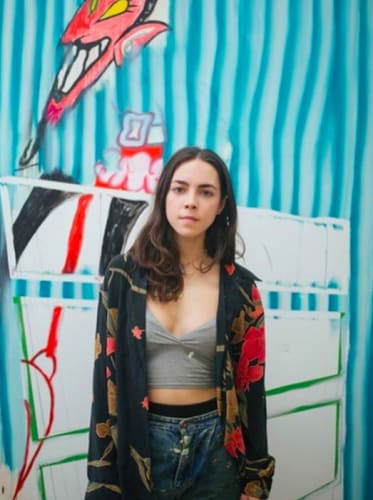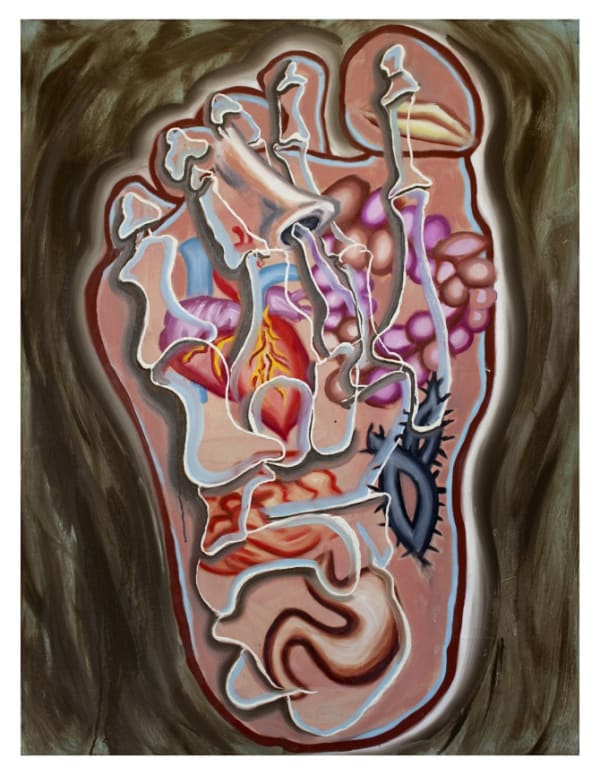INDIA NIELSEN
@INDIANIELSEN
In our interview we discuss her studio practices, her She Curates Shout Outs, her interesting titles and more.
Nielsen studded at @sladepainting @sladeschool and @rca_painting . Her work exists to me, as a deconstruction of language and communication. The works speak to me about deconstructing means of communication in this virtual era, through new visual languages and her often incorporated text.
I am such a fan of Nielsen’s work. She explores the relationship to ‘the screen’, finding something specific in a ‘stream of disconnected and disassociated imagery’.
Each of her paintings begins the process of being as writing. She writes about the direction it will take, feeling, motif… filling walls up with notes. ‘I think of them as similar to architectural notes’.
I always found her Titles very interesting. These are generated in different ways, ‘sometimes they are anagrams, initials, or coded messages’. But sometimes they can be very direct.
Nielsen embodies different artists in various aspects of her work ‘inhabiting them like an avatar’.
-
INTERVIEW
Tell us a bit about your journey to where you are now? Was there a conscious decision to be an artist? Was it never a choice?
I went to a Catholic primary school and when I was bored in class I’d make these drawings of angular people where I couldn’t take my pen off the paper. They looked quite a bit like cubist drawings, I had a book bag with Picasso’s ‘Three Musicians’ on it when I was really young so he was a big early influence on me. The drawings were usually female, always naked and looked a bit like pointed witches. I remember one of the prefects catching me doing them and telling me I wasn’t allowed to give them nipples… I was kind of embarrassed but even then I was mostly just really annoyed at how stupid and hypocritical that was. We all have them!
I don’t think there was one conscious decision to be an artist but it was always where I was headed. I suppose it was lots of little, incremental decisions. Each time I made a new decision art always took priority.
I know you have had an extensive education in some of the best art schools in London. Tell me about how you were trained, and how you adjusted to life as a working artist after being a student?
Technical training is pretty rare now, particularly in London art schools - I would go to life drawing classes and paint a lot on my own but I was never taught technique or how to paint. I figured it out through practice, and I’m still figuring it out - that might be why it’s called an artist’s “practice". You never stop practicing.
The schools I went to - The Slade School of Art and the Royal College of Art were different in many ways… The Slade only had 40 people across an entire year so it was a tiny community whereas the RCA is huge… there are so many people you can easily spend your two years there being anonymous if you want to. The one thing they both had in common that I really valued was that you had to do everything off of your own back. You were responsible for your own practice from the very beginning which made the transition out of being in an institution really easy.
Tell me about your studio? What are your artist essentials, and what does an average working day look like to you?I love my studio. I try and keep it as empty as possible and just have the basics… oil paint, a couple of tables, canvases..
You use many different artistic styles, colour and even text in your work. Who or what is your inspiration? And how does this come out in your incredible works?
I mentioned Picasso earlier as my first gateway artist when I was a kid and he remains one of my biggest inspirations. As I got older… Paul Thek, Francis Bacon, Charline von Heyl, Martin Kippenberger, Sigmar Polke, Peter Saul, the old Jeff Koons, Philip Guston, Oyvind Fahlstrom, Mike Kelley, Immendorff… I’m always looking and discovering new artists so my inspirations often change.
I often try and embody different artists for various aspects of my work, inhabiting them like an avatar. In some areas I feel like I’m inhabiting Picabia, while others might move through El Greco or Peter Saul. It’s both a way of removing myself from the equation while also allowing me to access different parts of my psyche by changing the way I approach my own thinking and behaviour.
I used to do this with music when I was a kid too… I would take on different personas of the artists I listened to. I think we often carry the habits we had when we were young and just inject them with different content in adulthood.
The process is akin to remixing - starting off with a proposition and using it to generate different images and tones.
Talk to me about titles? How do you produce and create such wonderful, half legible expressions? Where do these come from? How do they generate meaning for the works?
I started approaching the titles in a similar way to the imagery in the paintings. Sometimes they are anagrams, initials, or coded messages. Other times they’re very blunt and direct. I think this mimics the relationship I’ve had with verbal language throughout my life - I’ve always found it a bit of a struggle and been aware that it’s very difficult to communicate exactly what you think or feel. I often have cinematic dreams with recurring characters that are all trying to urgently communicate something to me but are blocked in some way… in one for example the character could only move his arms and laugh hysterically and in another he could speak, but only in mandarin. I think I carry through that feeling in my work, it often feels like I’m searching for something that’s always just out of shot. -
"A lot of my work is trying to consolidate this insider - outsider position, wanting to find something “real” (at least, to me) and specific in the general and the impassive. I’m looking for roots."
What are the main themes running through your work? What do you hope your work says/ people take away from it?
I think about my paintings in relationship to the screen… trying to find something local and specific in a stream of disconnected and disassociated imagery and information. I try not to worry about what people will read in my work, that’s not my job.
India, tell us, if you had to describe your work and practice in 3 words, what would they be?Oil on canvas.
How has pop culture, and religion influenced your work and the symbols you incorporate?
Religious art was one of my earliest entry points into art in general because I spent the first 6 years of my life in my Roman Catholic grandmother’s house. She’s a bit of a hoarder and her house was (and still is) full of religious icons. I used to share her superstitious belief that they had magic, protective powers and would carry them around with me in primary school.
So I had this kind of superstitious upbringing, and at the same time was growing up alongside the internet, which gave me access to images without necessarily being a part of their cultural source. I think the internet was just the next technological step in manifesting “pop culture” - it divorces images from their source and allows them to be commodified. I was really aware of that sense of pop culture being something that you have an intimate relationship with - it’s what you use to anchor most of the emotional experiences of your life, while also being on the outside of it - not really quite belonging to it.
A lot of my work is trying to consolidate this insider - outsider position, wanting to find something “real” (at least, to me) and specific in the general and the impassive. I’m looking for roots.I understand you don’t do preliminary sketches/ studies, you use text instead? How does your process work? What does it look like?
I do make drawings, but when I start paintings the process begins with writing. I start with writing about the direction I want the painting to take, describing the feeling I want it to have etc. When I paint, the wall around it is usually covered in notes I tack up to the wall as reminders. I think of them as similar to architectural notes.
Tell us a bit about the writing you do for galleries?
I mainly write for magazines. During lockdown I have started doing Skype interviews with artists for Imlabor (@imlabor), an online journal based in Tokyo. The next one up is with the painter Jason Fox which should be published in the next couple of weeks.What are you working on currently? And what would be your ultimate dream project?
I’ve just started a new body of work incorporating the fur pieces with the paintings. I don’t think in terms of projects but I’d like to do a museum show.Favourite historical female artist?
Lee Lozano, Frida Kahlo’s painted body casts, drawings and paintings, Artemisia Gentileschi, Agnes Martin, Helen Frankenthaler…
Favourite current practicing female artist?
There are so many: Isa Genzken, Kara Walker, Frances Stark, Tschabalala Self, Jana Euler, Charline von Heyl, Jutta Koether, Caroline Coon, Nicole Eisenmann, Lisa Brice, Tala Madani, Dana Schutz, Faith Ringgold, Amy Sillman, Mickalene Thomas, Judy Chicago, Lorna Simpson, Kiki Smith, Rose Wyllie…Who should She Curates interview next?
Any of the above, but Isa Genzken is the one for me.
Is there anything else you wanted to say?Nothing but my thanks! Hopefully see you on the other side…








